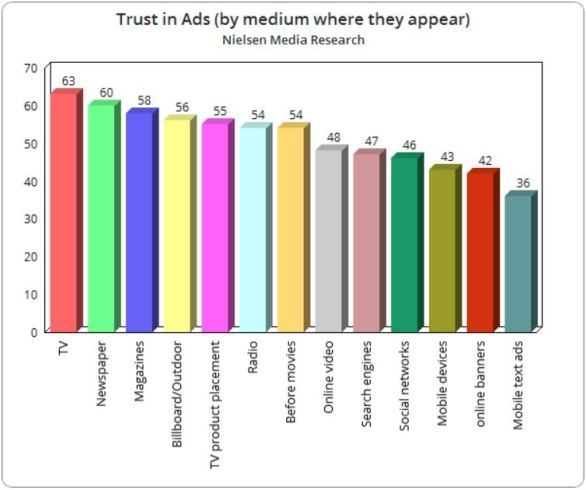Many D2C brands are moving digital dollars back to traditional marketing channels.
- Rising costs of digital mediums
- Need to build brand awareness, trust, and credibility
They are finding out that the direct response type campaigns that can work on search and social media channels will only take you so far. “As you evolve,” Melanie Travis, CEO and Bark & Co’s former Director of Brand Experience told Modern Retail, “you need to start branching out from direct response, which is bottom funnel.”
If you don’t fill the top of the funnel, she said, your direct response costs will rise more than what it’s worth. Travis and others are seeing increasing customer acquisition costs on Facebook and Google and it’s making some marketers question the value and whether it’s sustainable.
The other thing that comes in play, as it always has, is reputation. “It’s about legitimacy,” she said. People want to be able to see your brand in more places. This establishes credibility in your offers.
77% of consumers say they make purchase decisions based on a brand name and awareness. Awareness and credibility don’t happen the first time you see or hear a brand. It takes 5-7 impressions to produce even a slight amount of brand awareness. It takes consistently presenting your brand in a quality light over and over again.
“When a user browsing online sees a Google ad for a brand she already recognizes, you end up paying less for their click,” said Marcel Hollerbach, CEO of e-commerce platform ProductsUp, in Spots-n-Dots. “The whole marketing spec becomes more efficient and more effective.”
LINK: How Advertising Works
Consider the words of Thomas Smith
- The first time a man looks at an advertisement, he does not see it.
- The second time, he does not notice it.
- The third time, he is conscious of its existence.
- The fourth time, he faintly remembers having seen it before.
- The fifth time, he reads it.
- The sixth time, he turns up his nose at it.
- The seventh time, he reads it through and says “Oh brother.”
- The eighth time, he says, “Here’s that confounded thing again!”
- The ninth time, he wonders if it amounts to anything.
- The tenth time, he asks his neighbor if he has tried it.
- The eleventh time, he wonders how the advertiser makes it pay.
- The twelfth time, he thinks it must be a good thing.
- The thirteenth time, he thinks perhaps it might be worth something.
- The fourteenth time, he remembers wanting such a thing a long time.
- The fifteenth time, he is tantalized because he cannot afford it.
- The sixteenth time, he thinks he will buy it someday.
- The seventeenth time, he makes a memo to buy it.
- The eighteenth time, he swears at his poverty.
- The nineteenth time, he counts his money carefully.
- The twentieth time he sees the ad, he buys what it is offering.
Smith was a London businessman who wrote this back in 1885. That was back before people listened to radio, watched television, or had the internet. If it took 20 times back then, how many times does it take now?
Consider the Auto Industry
Car brands have some of the highest recall on the planet. They advertise on just about every platform nearly all the time. Yet, without prompting, many consumers are unable to recall specific brand names. Those that do are more likely buyers. A Nielsen study shows vehicle shoppers that can recall specific brands unaided have 10X the purchase intent of those that only see the brand with aided awareness.
In other words, when they know the brand, they are ten times more likely to buy as opposed to seeing an ad with an unknown brand, or a brand they only see for the first time.
Trust In Advertising
The Edelman Trust Barometer tracks consumer attitudes about brands. According to Edelman, 80% of U.S. consumers buy from companies they trust and 63% say they won’t buy from companies that haven’t earned that trust.
When it comes to the environment where ads are seen, it makes a difference. A Nielsen study show that the proliferation of online formats has not eroded trust in traditional media. TV, newspaper, magazines, and radio still remain the most trusted advertising formats for consumers.
Do you completely or somewhat trust advertisements you see in…

